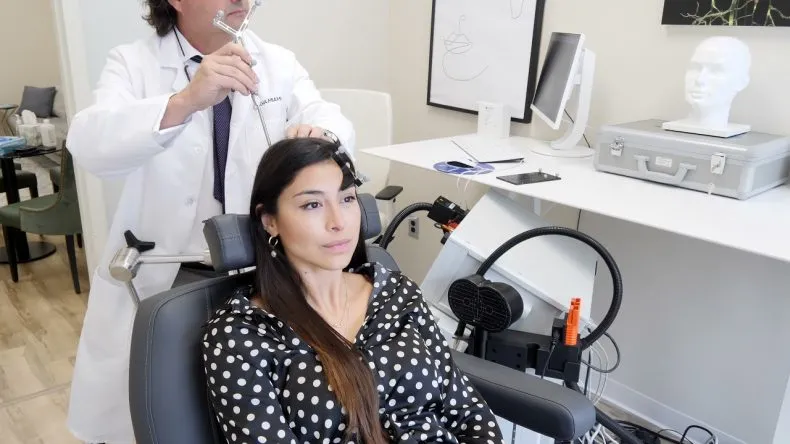Transcranial magnetic stimulation (TMS) is a Food and Drug Administration (FDA) approved treatment for depression. It is a safe, non-invasive treatment that delivers magnetic pulses to stimulate nerve cells in specific brain regions to treat symptoms of depression.
In addition to effectively treating depression, especially among those who have not seen improvement with medication, TMS is now used in treating anxiety.
What Is TMS?
TMS, often otherwise known as rTMS, is a pain-free outpatient procedure that involves delivering repetitive transcranial magnetic stimulation. Since the 1980s, TMS has been used to treat depression and anxiety by enhancing brain activity, usually within the dorsolateral prefrontal cortex (DLPFC). Here, it delivers medical pulses via a magnetic coil that sends alternating pulses to neurons, stimulating an area of the brain.
With the advancement of medical knowledge, technologies, and safety techniques, there is less than a 0.1% chance of seizure or loss of consciousness and very few side effects, meaning people can return to their daily routine immediately after the procedure.
Each treatment session is around forty minutes long, and those receiving TMS generally undergo the procedure four or five times per week for a duration of four to six weeks.
How Does TMS Treat Anxiety?
Anxiety disorders such as generalized anxiety disorder and social anxiety disorder cause hyperactivity in the amygdala. The amygdala plays an essential role in processing emotions, especially in stressful or life-threatening situations, which may trigger the fight or flight response.
For those with an anxiety disorder, having a hyperactive amygdala can cause excessive and disruptive worry or stress, characterizing symptoms of GAD. Transcranial magnetic stimulation treats anxiety by lowering neurons to normal activity levels.

TMS Therapy for Anxiety- Does TMS Work for Anxiety?
As well as treating depression, TMS treatment is used to treat behavioral health conditions, such as post-traumatic stress disorder (PTSD), obsessive-compulsive disorder (OCD), bipolar disorder, and anxiety disorders.
Anxiety is currently the most commonly diagnosed mental illness in the US, with generalized anxiety disorder (GAD) affecting 6.8 million adults in any given year, according to the Anxiety and Depression Association of America. Though research is still relatively limited, doctors have seen great success in using TMS to treat anxiety, providing a sense of hope for millions of Americans.
GAD is characterized by persistent and excessive stress or worries about various things. It is most common in childhood and middle age and can become debilitating at times, stopping people from taking part in activities, getting jobs, and forming relationships, among other things.
Symptoms of GAD include, but are not limited to:
-Feeling nervous, irritable, or on edge
-Feeling an impending danger, doom, or panic
-Increased heart rate
-Rapid breathing or even hyperventilation
-Sweating or trembling
-Feeling weak or tired
-Experiencing difficulty concentrating
-Difficulty sleeping or insomnia
-Gastrointestinal issues
-Panic attacks
Effectiveness of TMS
Transcranial magnetic stimulation therapy has mainly been studied as a treatment for major depressive disorder, or depression, although the FDA has very recently approved treatment for OCD. The success rate of TMS treatment for depression is promising, with between 30 and 64% responding positively and experiencing reduced symptoms. However, additional research is needed to determine the success rate for other medical conditions, such as anxiety.
Like any form of treatment, TMS may not be effective for everyone. Treatments like cognitive-behavioral therapy (CBT) and anti-anxiety medications are also not always effective. For example, approximately 30% of people with medication-resistant depression don’t respond to psychotherapy or medication. Nearly half of those in America who are diagnosed with depression are also diagnosed with an anxiety disorder, and so it is important to consider that both of these conditions can go hand-in-hand.
Read more: What is the success rate of TMS Therapy
The treatment of anxiety with TMS is relatively new, and so there is only a small bank of research to consider. However, results are promising and side effects minimal, especially when compared to the side effects of anti-anxiety medication. Side effects, such as nausea, indigestion, and agitation, commonly associated with anxiety medications, are also avoided using TMS therapy.
Moreover, studies have shown noteworthy improvement for people diagnosed with anxious depression or depression and comorbid anxiety. In cases such as these, both depression and anxiety disorder symptoms are reduced through TMS treatment.
Related article: TMS Therapy for autism
Side Effects of TMS
One of the primary side effects reported by those going through TMS therapy is temporary discomfort at the treatment area during the session. This generally only occurs for the first week of treatment.
Read more: Pros and Cons of TMS Therapy
Clients typically feel a very light tapping on their heads during the treatment session. Clients also report hearing clicking sounds from the magnetic coil that the health professional administers during TMS treatment.
Transcranial magnetic stimulation side effects are extremely uncommon. However, if complications do arise, physical symptoms may include:
-Mild headaches
-Lightheadedness
-Scalp pain
-Neck pain
-Tingling sensations
-Facial twitching
-Sleepiness
There is also a 0.1% risk of developing seizures during a course of TMS therapy. Generally, less than 5% of people stop receiving TMS therapy due to adverse effects.
Can TMS Make Anxiety Worse?
Some studies have shown that when TMS is used to treat depression, anxiety symptoms can increase. However, anxiety is not listed as a side effect of TMS therapy, and there is no evidence to show that TMS makes anxiety worse. The vast majority of people report feeling calmer with a higher ability to cope with stressors.
Results from a trial in 2011 exhibited that people with panic disorder reported that repetitive transcranial magnetic stimulation caused higher anxiety levels. However, there has not been any conclusive evidence to list anxiety as a side effect of TMS.
Read more: How much does TMS Therapy Cost
If clients begin suffering from intense anxiety symptoms when they commence TMS treatment, they are advised to speak to a doctor. Related: TMS saved my life from anxiety
To Conclude
TMS is an effective treatment for people living with mental health issues due to targeting the activity of nerve cells in the brain, which may alleviate depression symptoms. It is also a promising treatment for anxiety conditions and other disorders, like OCD and PTSD.
Deep transcranial magnetic stimulation may even be helpful for Parkinson’s disease, multiple sclerosis, and Alzheimer’s disease.
While many insurance providers do not cover TMS for anxiety yet, insurance for clients who have a dual diagnosis of depression and anxiety may cover TMS therapy.
Read more: TMS Therapy for ADHD









